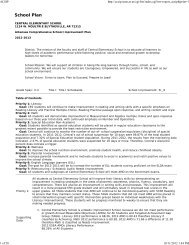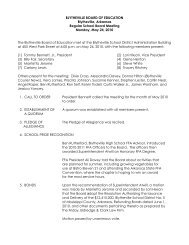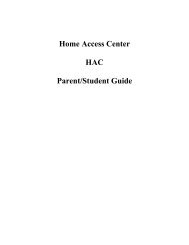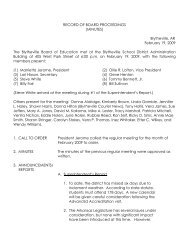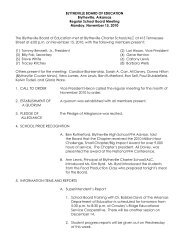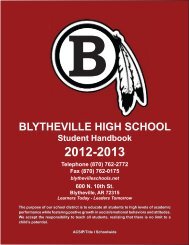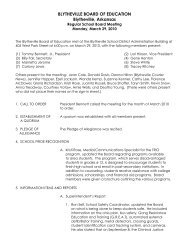District-Wide Safe Schools and Crisis Plan - Blytheville Public Schools
District-Wide Safe Schools and Crisis Plan - Blytheville Public Schools
District-Wide Safe Schools and Crisis Plan - Blytheville Public Schools
You also want an ePaper? Increase the reach of your titles
YUMPU automatically turns print PDFs into web optimized ePapers that Google loves.
6. Monitor how staff is assessing students for the emotional impact of the crisis.<br />
7. Maintain contact with the Principal <strong>and</strong> Director of <strong>Safe</strong>ty to acquire<br />
information about the response operations <strong>and</strong> to report potential problems.<br />
8. Conduct daily debriefings for faculty, staff <strong>and</strong> others assisting in the<br />
recovery. The Director of <strong>Safe</strong>ty will be resources for assistance.\<br />
9. Through collaboration between site recovery professionals, Director of <strong>Safe</strong>ty, <strong>and</strong><br />
Emergency management First Responders; persons identified as needing longterm<br />
care will be referred to local mental health <strong>and</strong> other human service providers.<br />
10. Critique the incident recovery efforts <strong>and</strong> activities using feedback from<br />
members of the Mississippi County Emergency Response, the <strong>District</strong> <strong>Crisis</strong><br />
Response Team, faculty <strong>and</strong> staff, students <strong>and</strong> community members.<br />
I.1.(D) SAMPLE SCHOOL CRISIS INTERVENTION ACTIVITIES<br />
Trauma experts emphasize the need to create a caring, warm, <strong>and</strong> trusting environment<br />
for students following a crisis. Allow students to talk about what they felt <strong>and</strong><br />
experienced during the traumatic event. Younger children who may not be able to fully<br />
express their feelings verbally will benefit from participating in creative activities,<br />
including drawing, painting, or writing stories. Young adolescents benefit from group<br />
discussions in which they are encouraged to talk about their feelings, as well as from<br />
writing plays or stories about their experiences. Engage older adolescents in group<br />
discussions, <strong>and</strong> address any issues of guilt (“I could have taken some action to change<br />
the outcome of the crisis”).<br />
Elementary (grades K-5) Secondary (grades 6-12)<br />
Draw-a-picture Art, music, dance<br />
Tel l-a-story Stories, essays, poetry, video production<br />
Books on disaster <strong>and</strong> loss Books on disaster <strong>and</strong> loss<br />
Create a play or puppet show about a<br />
disaster<br />
Create a play, or video about a disaster<br />
Create a game about a disaster, disaster<br />
preparedness, or disaster recovery<br />
Group discussions about disaster,<br />
disaster preparedness, or disaster<br />
recovery<br />
School study projects School projects on health or natural <strong>and</strong><br />
social sciences<br />
Materials about disaster safety <strong>and</strong> self Materials about disaster safety <strong>and</strong> self,<br />
<strong>and</strong> family protection<br />
family, <strong>and</strong> community protection<br />
Masters of Disaster, available from Red<br />
Cross<br />
School service projects<br />
Reprinted <strong>and</strong> adapted from Lystad, M. (Ed.). (1990). Innovations in Mental Health<br />
Services to Disaster Victims (DHHS <strong>Public</strong>ation No. ADM 90-1390). Washington, DC:<br />
US Government Printing Office.<br />
69






